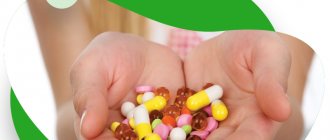Antibiotics are used for infectious diseases caused by bacteria. They either destroy pathogenic microorganisms (bactericidal drugs) or limit their proliferation (bacteriostatic antibiotics), leaving the immune system to fight the infection itself.
In order for antibiotics to be effective, you must follow certain rules for taking them.
Antibiotics are prescribed by the doctor
Only a specialist can choose the appropriate drug from the huge number of items produced by the pharmaceutical industry. When prescribing a medicine, the doctor takes into account the disease, age and condition of the patient, the presence of concomitant pathologies, and the side effects of the drug. And if the doctor prescribed you an antibiotic, you need to take it.
Today there are two extreme points of view regarding antibiotics. Some consider them an absolute evil and refuse treatment. Others, on the contrary, are ready to swallow antibiotics for any cold. Both are wrong.
Yes, indeed, this group of drugs is far from harmless, and while killing pathogenic microbes, they also destroy beneficial microflora. But in case of severe infections, you cannot do without them. By refusing to take the pills, you risk ending up in a hospital, where you will be given the same antibiotics, but by injection or through an IV, and in much larger doses.
Those who try to treat a runny nose with antibiotics (and this is a viral infection that antibiotics have no effect on) will not get rid of the disease, but they may suffer from the side effects of the drug.
Is it possible to overcome resistance?
Over time, the bacteria adapt by producing genes that protect against the effects of antibiotics. If a person becomes infected with such bacteria, it is much more difficult to treat. This process is on a planetary scale, and doctors themselves are largely to blame for the problem. They often thoughtlessly use broad-spectrum antibiotics, which, like carpet bombing, destroy the microflora of the mucous membranes.
“It’s easier to prescribe an antibiotic to a child with a high fever or an unconscious intensive care patient and not worry about further treatment,” complains therapist and medical blogger Philip Kuzmenko. “The doctor simplifies his work by shooting sparrows out of a cannon and achieves the patient’s recovery, but at too high a cost.”
The next time the same disease overtakes a recovered person, the previous medicine may not work, since the bacteria have learned to resist it. In this arms race, microbes have a clear advantage. There will always be bacteria against which even the latest generation of drugs will be powerless.
“Self-medication with antibiotics is the murder of our grandchildren and great-grandchildren,” Dr. Kuzmenko is convinced. — Every day I receive letters that inexperienced or incompetent doctors prescribe antibiotics for ARVI. The mortality rate from influenza does not exceed 2−3%, and from a bacterial infection, for which there is no cure, it reaches 50%. Personally, in the first year of practice I prescribed antibiotics often, then less often, and in the 4th-5th year - almost never. There are 3 groups of so-called antibiotics of choice or first line: penicillins, macrolides and cephalosporins. These drugs are prescribed in case of a threatening situation even before confirmation of an accurate diagnosis. It is a myth that pneumonia can be “heard out” at an early stage, but in some cases the patient may not even make it to the pharmacy. Therefore, empirically, from a variety of antibiotics, “broad-spectrum” drugs were selected that act on 20–25 species of bacteria.”
Antibiotics must be taken strictly according to the schedule
Your doctor will tell you your dosage regimen. In addition, each drug has instructions that describe in detail when (morning, evening, before/after meals) and how many times a day the medicine should be taken. Antibiotics should be taken at the same time, and the intervals between doses should be equal. Usually the drug is taken 1-2-3-4 times a day, which means the intervals should be 24-12-8-6 hours. This is the period of time the pill works, then its effect ends, and if you miss the time of taking it, the bacteria will begin to multiply intensively, poisoning the body. In addition, microorganisms may develop resistance to this antibiotic.
Accounting for medications used
It is advisable to keep records of all antibiotics used. Namely, it is worth recording the duration of the course, the name of the medicine, when it was taken and for the treatment of what disease. This is recommended not only for children, but also for adults.
During use, you need to take into account the body’s reaction to the drug, the development of possible side effects, and allergies. This will help the doctor adequately assess the situation and prescribe the most effective antibacterial agent.
It is also important to warn the specialist about the use of additional drugs that have been used recently or currently.
You need to complete the full course of treatment
As a rule, if the antibiotic is effective, improvement occurs on the 3rd day of treatment. But this does not mean recovery. You should not interrupt the course, even if you feel much better. By stopping taking the medicine ahead of time, firstly, you will soon feel worse, since not all bacteria have been destroyed, and secondly, your bacteria will become resistant to this antibiotic and in the future it will no longer act on them. You will get the same result if, after feeling an improvement in your condition, you reduce the dose of the drug.
Can only be used as prescribed by a doctor
It is very important to take antibacterial agents only in cases where you cannot do without them. It is unacceptable to take medications on your own initiative. Indications for the use of antibiotics include various symptoms of infectious diseases that cannot be treated on your own:
- Prolonged high temperature.
- Purulent processes.
- Exacerbations after pathologies of a bacterial nature.
- Disturbance in the structure of the circulatory system. There is an increase in the level of white cells, an increase in ESR and other characteristic signs indicating inflammation.
It is worth remembering that antibacterial agents are not effective against viruses. Therefore, this pharmacological group is not prescribed to patients to combat influenza, ARVI, and intestinal infections.
A little bit of history
One of Alexander Fleming's early works showed that sensitive bacteria can “get used” to penicillin in laboratory conditions. In 1945, when he was awarded the Nobel Prize, Fleming told the story of an imaginary patient who had a sore throat caused by Streptococcus pyogenes and who took a shorter course of penicillin than required. This led to transmission of the infection - already in a resistant form - to his wife, who did not respond to therapy. Fleming concluded: “If you are taking penicillin, use the full course.” It's funny, but Streptococcus pyogenes never shows resistance to penicillin.
Taking probiotics
Everyone knows that antibacterial drugs have a detrimental effect on the intestinal microflora, especially with long-term use. Therefore, during the course of treatment you should additionally take probiotics and consume various dairy dishes. It is advisable to take such medications between intervals of taking the main drug.
Effective representatives of probiotics: Linex, Bifiform, Acipol, Normoflorin. It is advisable to consult a doctor about choosing the appropriate remedy.
Before, after or during meals?
For some medications, taking them exactly as scheduled is very important.
If the medicine is prescribed to be taken, say, “30 minutes before meals,” this means that the patient will not eat for some time before using the drug and for 30 minutes after use. The medicine should go into an empty stomach, where it will not be interfered with by food particles.
With the “during meals” option, everything is more or less clear; it is only important to check with your doctor how much food should be consumed while taking the medicine.
The point “after meals” implies taking the drug after a certain amount of food, so that the medicine does not irritate the gastric mucosa or helps normalize digestion.
Please note that if the instructions do not specify the time of administration, the drug is taken on an empty stomach.
Follow the instructions. If you drink it with water
Tea, coffee, orange, apple and any other juices, milk and dairy products - in most cases, all this is not suitable for washing down antibiotics intended for oral administration. These drinks speed up the elimination of the drug and may reduce the effectiveness of treatment. 5 Juices also contain various acids that can react with medications and cause unwanted reactions.6
It is most rational to use water when taking medications, unless otherwise indicated in the instructions. Be sure to read it before starting treatment. Tea and coffee are also undesirable because they contain caffeine, tannins and catechins, which can alter the absorption and pharmacological action of many drugs.7
Relationship between duration of antibiotic therapy and resistance
- Traditionally, recommendations determine the duration of antibiotic use. However, for most drugs, studies have not been conducted to determine the minimum effective treatment period. For example, pyelonephritis is historically treated for 2 weeks. At the same time, clinical studies have proven that a longer period of fluoroquinolones is effective (7 days for ciprofloxacin and 7 days for levofloxacin), but similar work has not been carried out for β-lactam antibiotics, which are most often used in the treatment of pyelonephritis. Looking at current international guidelines, a course of β-lactam antibiotics should be 10–14 days, based on the simple lack of data on the effectiveness of shorter periods of therapy.
- On the other hand, randomized clinical trials have shown that a shorter period of therapy in patients with hospital-acquired pneumonia is similar in clinical outcomes to a longer course, but is associated with a lower risk of recurrent infection and antibiotic resistance.
- The concept of a universal antibiotic course duration does not take into account that patients respond differently to the same drugs. Recently, the situation has changed dramatically in hospital practice, where the decision to discontinue therapy is increasingly based on biomarkers such as procalcitonin. It is not always possible to perform such tests in an outpatient setting, which is why some experts are inclined to think so. that patients can stop therapy when they feel better. Of course, this statement contradicts the WHO recommendation. But, interesting are the results of a recently published study showing that using temperature resolution as an indicator of cessation of therapy in patients with community-acquired pneumonia reduces the duration of treatment by 2 times without affecting the success of therapy.
Thus, clinical studies are required to determine the most effective strategies for optimizing the duration of antibiotic therapy.
Source
: Martin J Llewelyn, Jennifer M Fitzpatrick, Elizabeth Darwin. BMJ 2017;358:j3418.
Person's disposition
For some medications, the position in which you take them is important. For example, capsules that have a gelatin shell are recommended to be taken while standing with plenty of water to prevent the shell from sticking to the wall of the esophagus. And, here are some medications that affect blood pressure that are recommended to be taken while lying down.
As you can see, there are a lot of nuances that need to be taken into account when using medications. The cause of a long-term illness or the appearance of negative reactions in the body may be the incorrect use of medication. Be sure to read the instructions and consult with specialists!








